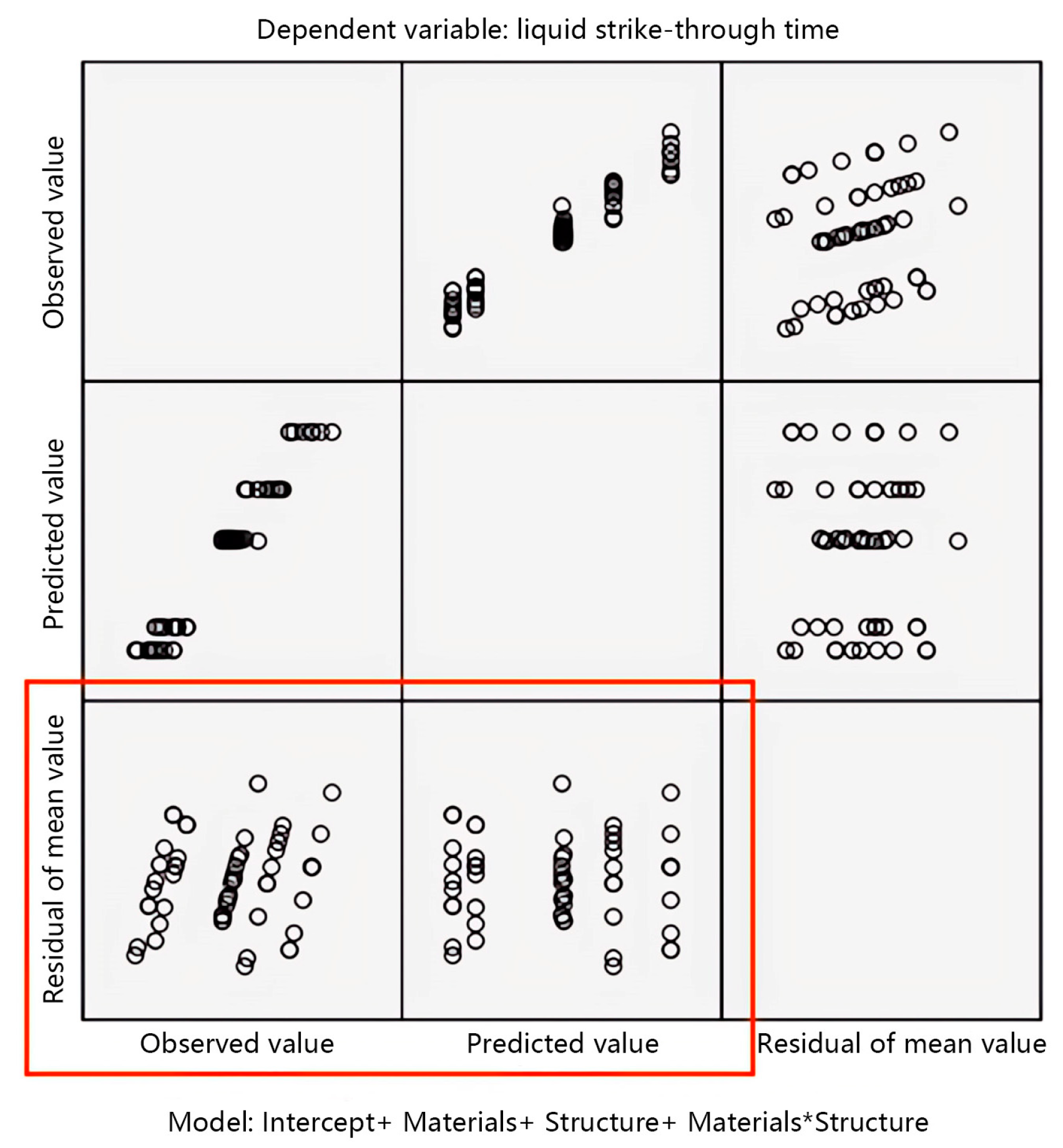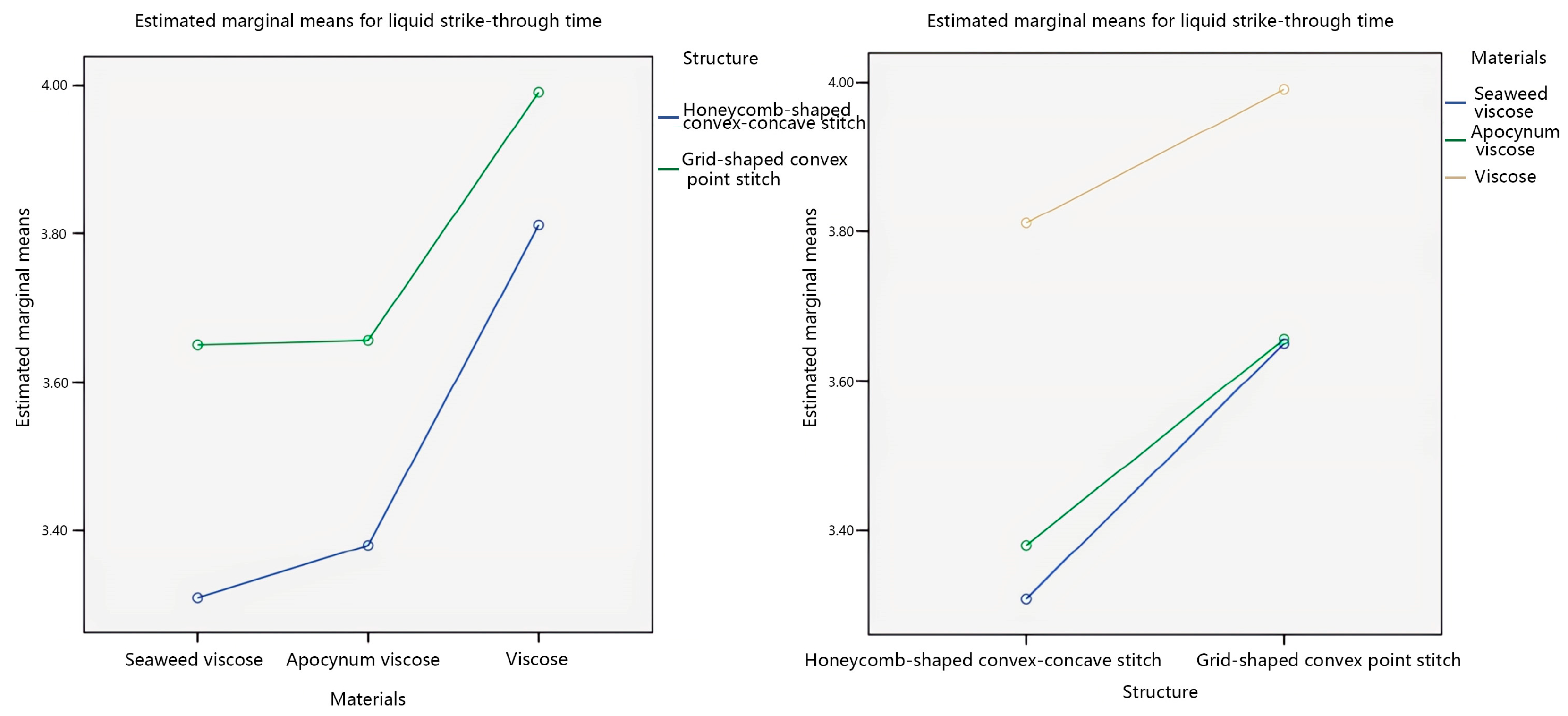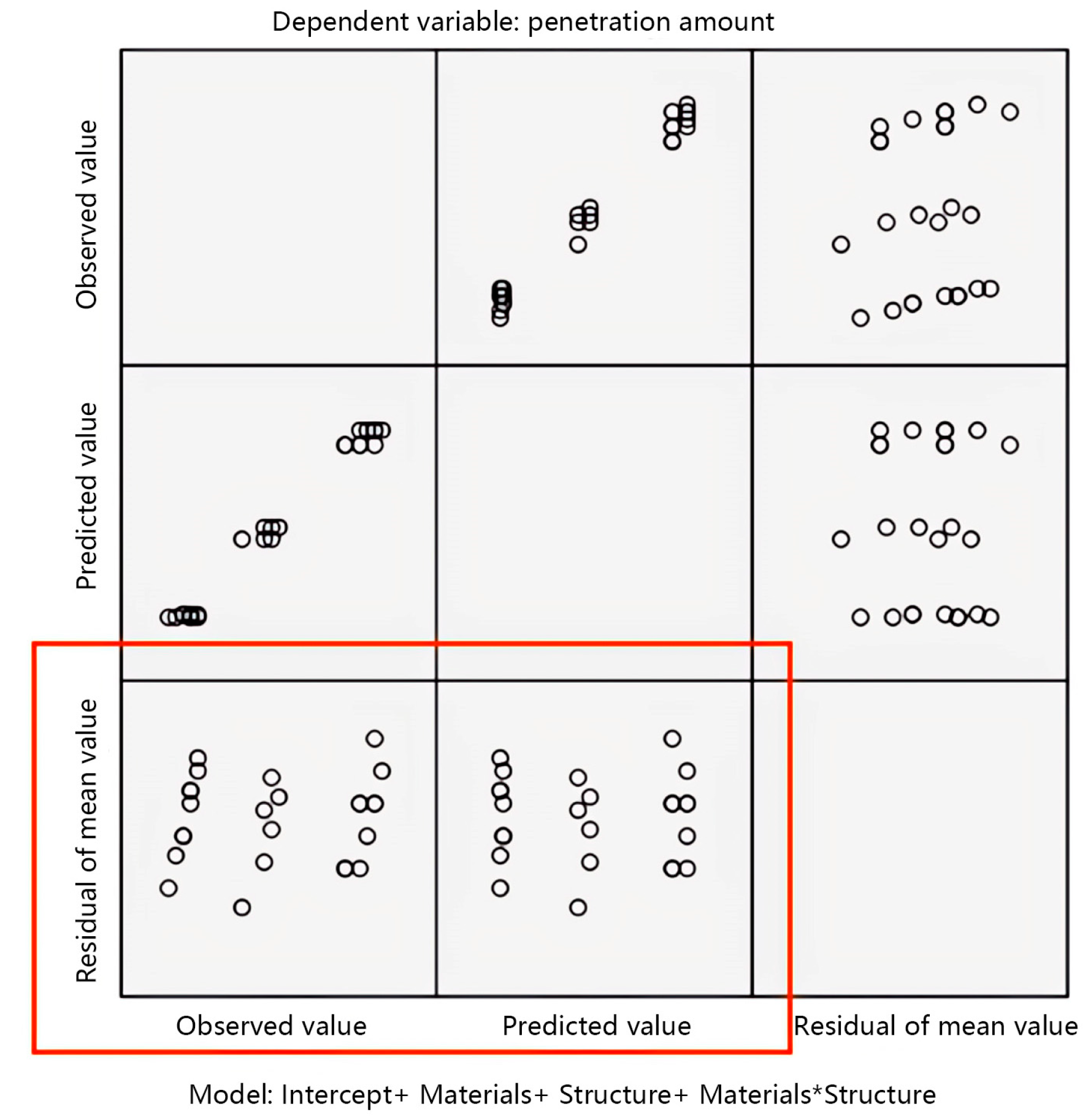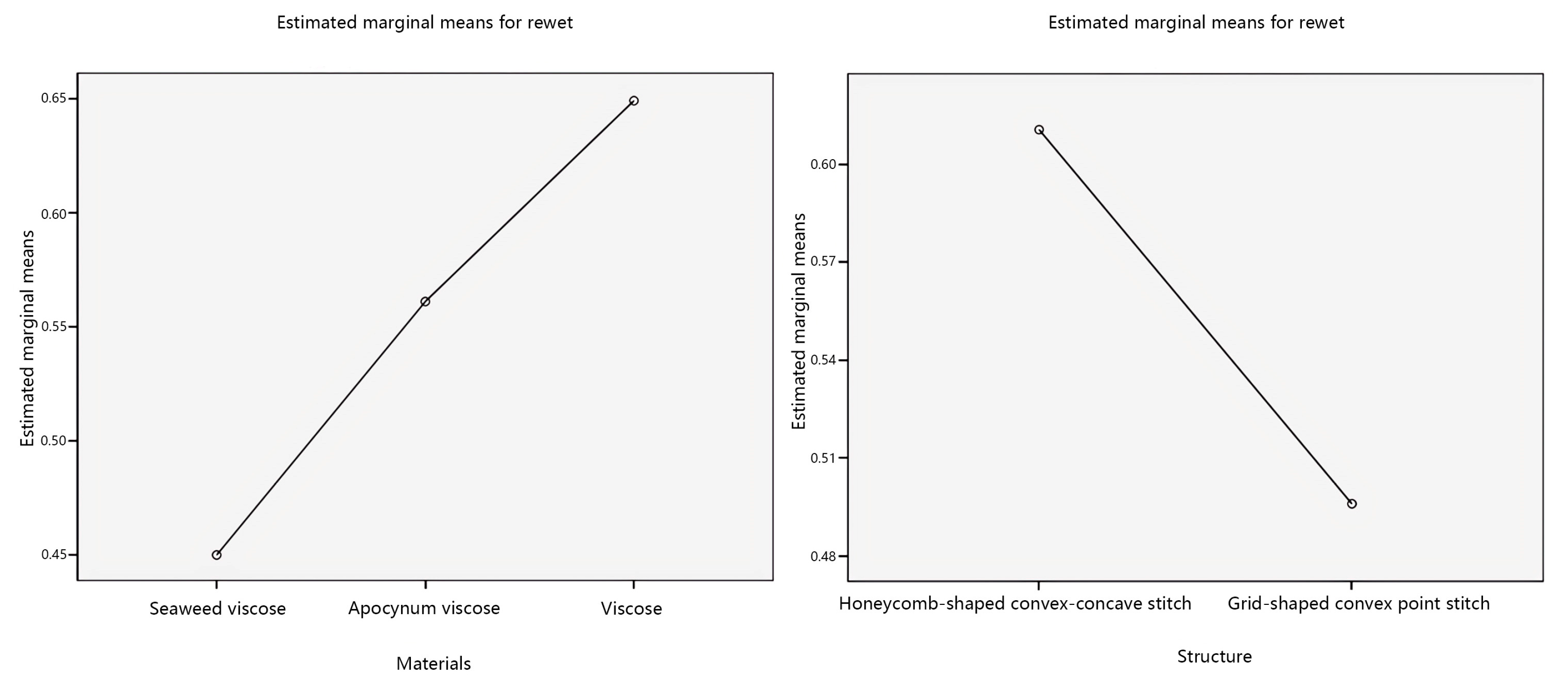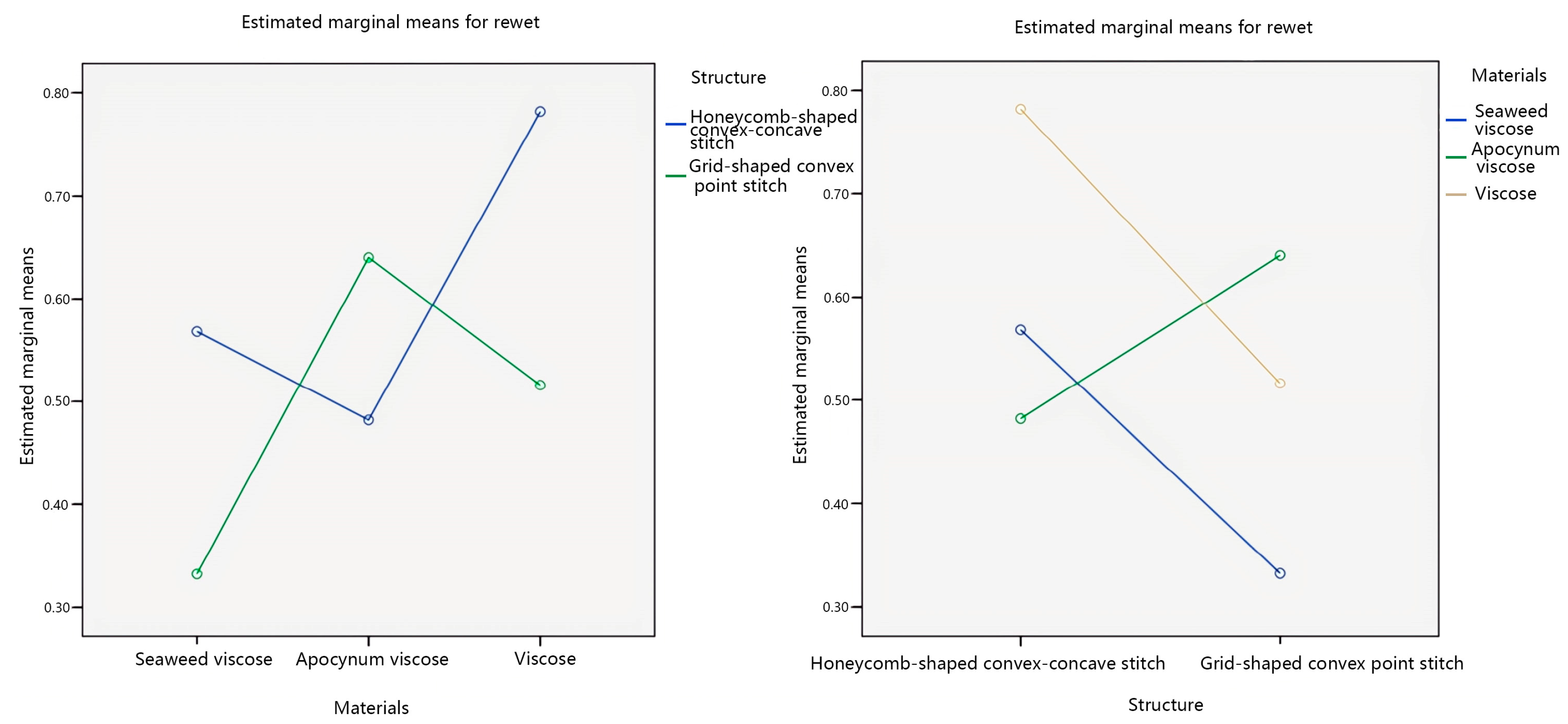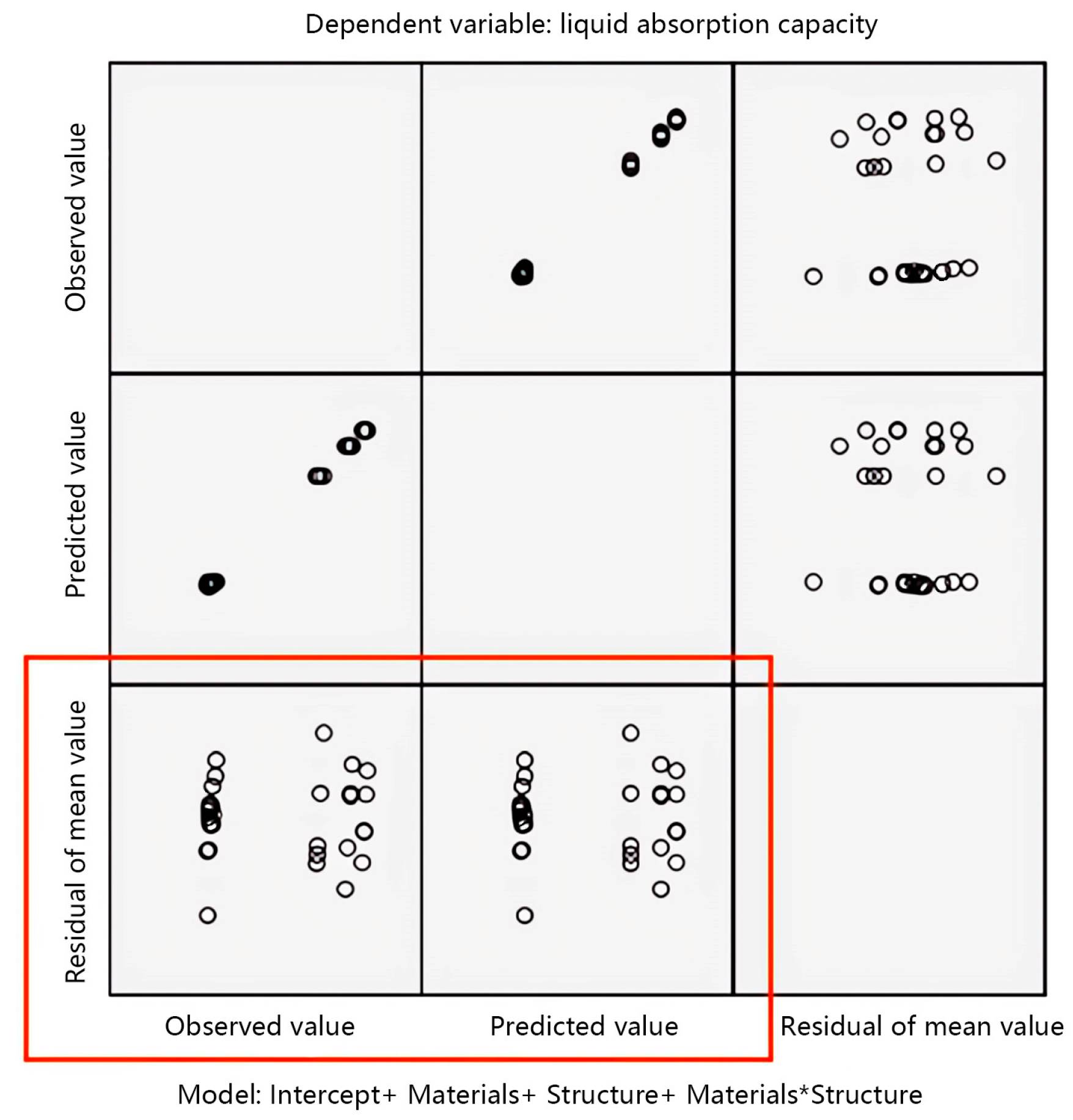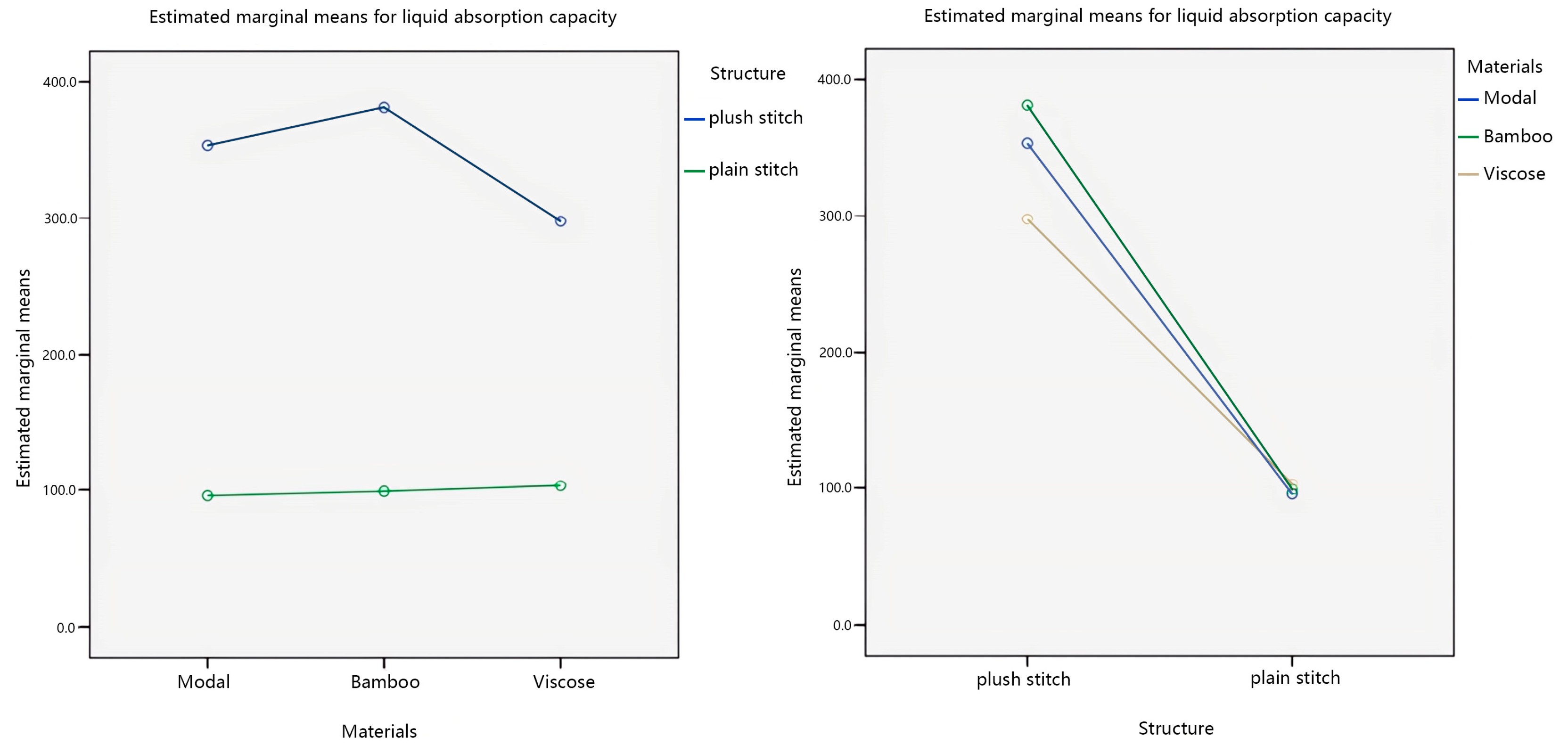3.1.1. Study on Fabric Structure Parameters and Liquid Strike-Through Time of Seamless Knitted Fabric with Crotch Penetration Layer
According to the standard GB/T 24218.13-2010 Textiles-Test methods for nonwovens Part 13: Repeated liquid strike-through time, liquid strike-through time tests were conducted on samples #1–#6. The results of the liquid strike-through time tests for each seamless knitted fabric are shown in
Table 4.
The liquid strike-through time is an important indicator for measuring the permeability of fabrics. The liquid quickly penetrates from the surface of the crotch penetration layer to the crotch absorption layer. The shorter the liquid strike-through time, the faster the liquid penetration speed of the crotch penetration layer, and the better the crotch penetration performance [
25]. According to the data analysis in
Table 4, the larger the liquid contact surface area, the shorter the liquid penetration time of the fabric, and the better the penetration performance of the fabric. The raw material for the veil is seaweed viscose yarn, and sample #7 with honeycomb-shaped convex–concave stitching has the shortest liquid strike-through time and good permeability. The raw material for the veil is viscose yarn, and sample #12 with grid-shaped convex point stitching has the longest liquid penetration time and poor permeability. The order of liquid penetration time from short to long is #1 < #2 < #4 < #5 < #3 < #6.
Conduct one-way ANOVA using SPSS software to further explore the relationship between yarn raw materials, fabric structure, and liquid strike-through time. Due to the presence of two independent variables, veil raw material and fabric structure, and six liquid strike-through time data samples in this experiment, there is a problem with the small sample size of experimental data, which may affect the analysis of experimental results. Therefore, during the analysis of variance, 10 sets of experimental data were entered into the database, totaling 60 data samples. The analysis results are shown in
Table 5.
From the data analysis in
Table 5, the significance level of the material is
p < 0.05, the significance level of the fabric structure is
p < 0.05, and the significance level of the material*structure is
p < 0.05. This indicates that the single factor of the veil raw material and fabric structure has a significant impact on the liquid strike-through time, and the interaction between the veil raw material and the fabric structure is significant. Secondly, the data of the three follow a normal distribution and have statistical significance.
This study uses the normality condition to test the accuracy of the variance analysis results of fabric structural parameters and liquid strike-through time. The test results are shown in
Figure 2.
The accuracy of the observation test results is mainly achieved by observing the scatter plot as the vertical axis in the standard residual plot. From the standard residual plot in
Figure 2, it can be observed that the distribution of each point in the scatter plot of the residual is uniform and there is no obvious pattern to follow, indicating that the data approximately follow or follow a normal distribution with homogeneous variance. The analysis of variance method can continue to be used.
Further, investigate the influence of individual factors on liquid strike-through time, and the main effect plots of the estimated marginal mean of liquid strike-through time are shown in
Figure 3.
Analyzing the main effect plots in
Figure 3, with the veil material as the independent variable, the estimated marginal average of the liquid strike-through time of seaweed viscose yarn is relatively low. The estimated marginal average of the liquid strike-through time of honeycomb-shaped convex–concave stitching is relatively low, with the fabric structure as the independent variable. Secondly, with the veil material as the independent variable, the order of liquid strike-through time from short to long is seaweed viscose yarn < apocynum viscose yarn < viscose yarn. The order of liquid strike-through time from short to long, with fabric structure as the independent variable, is honeycomb-shaped convex–concave stitching < grid-shaped convex point stitching.
This study considers the interaction between the veil material and the fabric structure, which affects the liquid strike-through time of seamless knitted fabrics. Therefore, a pairwise comparison was made between the veil material and the fabric structure, as shown in
Figure 4.
Analyzing
Figure 4, it can be observed from the plots that in the interaction plots of the two factors with the veil material as the independent variable, there is no intersection between the honeycomb-shaped convex–concave stitch line and the grid-shaped convex point stitch line. In the interaction plots of the two factors with fabric structure as the independent variable, there is an intersection between seaweed viscose yarn creases and apocynum viscose creases. This indicates that there is an interaction between the veil material and the fabric structure regarding the liquid strike-through time, and the interaction is significant. In addition, the fabric structure has a more significant effect on the liquid strike-through time of seamless knitted fabrics than the veil material, which is consistent with the significance analysis results of the material*structure obtained from
Table 5.
3.1.2. Study on Fabric Structure Parameters and Penetration Amount and Rewet of Seamless Knitted Fabric with Crotch Penetration Layer
According to standard GB/T 30133-2013 The specification of coverstock for sanitary absorbent pads, samples #1–#6 were tested for the penetration amount and rewet, and the penetration performance test results of each seamless knitted fabric are shown in
Table 6.
The penetration amount and rewet are two important indicators for measuring the permeability of fabrics. The more the penetration amount, the less rewet, indicating better permeability of the fabric. According to the data analysis in
Table 6, the raw material for the veil is seaweed viscose yarn, and the penetration amount of #4 with grid-shaped convex point stitching is the highest. The raw material for the veil is viscose yarn, and the penetration amount of #6 with grid-shaped convex point stitching is the lowest. The raw material for the veil is seaweed viscose yarn, with grid-shaped convex point stitching having the least amount of rewet. The raw material for the veil is viscose yarn, with honeycomb-shaped convex–concave stitching having the most amount of rewet. The order of the seamless knitted fabric penetration amount from more to less is #4 > #5 > #1 > #2 > #3 > #6, and the order of seamless knitted fabric rewet from less to more is #4 < #2 < #6 < #1 < #5 < #3.
Conduct one-way ANOVA using SPSS software to further explore the relationship between yarn raw materials, fabric structure, and penetration amount. Due to the presence of two independent variables, veil raw material and fabric structure, and six penetration amount data samples in this experiment, there is a problem with a small sample size of experimental data, which may affect the analysis of experimental results. Therefore, during the analysis of variance, five sets of experimental data were entered into the database, totaling 30 data samples. The analysis results are shown in
Table 7.
From the data analysis in
Table 7, the significance level of the veil raw material is
p < 0.05, the significance level of the fabric structure is
p < 0.05, and the significance level of the material*structure is
p < 0.05, indicating that the single factor of the veil raw material and fabric structure has a significant impact on the penetration amount. The interaction between the veil raw material and the fabric structure is significant. Secondly, the three data categories follow a normal distribution and have statistical significance.
This study uses the normality condition to test the accuracy of the variance analysis results of fabric structural parameters and penetration amount. The test results are shown in
Figure 5.
The accuracy of the observation test results is mainly achieved by observing the scatter plot as the vertical axis in the standard residual plot. From the scatter plot of the mean residual in
Figure 5, it can be observed that the distribution of each point in the scatter plot of the residual is uniform and there is no obvious pattern to follow, indicating that the data approximately follow or follow a normal distribution with homogeneous variance. The analysis of variance method can continue to be used.
Further, investigate the influence of individual factors on the penetration amount, and the main effect plots of the estimated marginal mean values of the penetration amount are shown in
Figure 6.
Analyzing the main effect diagram in
Figure 6, with the veil material as the independent variable, the estimated marginal mean value of the penetration amount of seaweed viscose yarn is relatively high. The estimated marginal mean value of the penetration amount of the grid-shaped convex point stitch is relatively high, with the fabric structure as the independent variable. Secondly, with the veil raw material as the independent variable, the order of the penetration amount from more to less is seaweed viscose yarn > apocynum viscose yarn > viscose yarn. The order of the penetration amount from more to less, with the fabric structure as the independent variable, is grid-shaped convex point stitching > honeycomb-shaped convex–concave stitching.
This study considers the interaction between the veil raw material and the fabric structure, which affects the penetration amount of seamless knitted fabrics. Therefore, a pairwise comparison was made between the veil raw material and the fabric structure, as shown in
Figure 7.
Analyzing
Figure 7, it can be observed from the plots that in the interaction plots of the two factors with the veil material as the independent variable, there is an intersection between the honeycomb-shaped convex–concave stitch line and the grid-shaped convex point stitch line. In the two-factor interaction diagram with fabric structure as the independent variable, there is no intersection between the three broken lines of seaweed viscose yarn, apocynum viscose yarn, and viscose yarn. This indicates that there is an interactive effect between the veil raw material and the fabric structure on the penetration amount, and the interaction is significant. In addition, the influence of the veil raw material on the penetration amount of seamless knitted fabrics is more significant than that of the fabric structure, which is consistent with the significance analysis results of the material*structure obtained from
Table 7.
- 2.
Fabric structure parameters and rewet analysis:
Conduct one-way ANOVA using SPSS software to further explore the relationship between veil raw material, fabric structure, and rewet. Due to the presence of two independent variables, veil raw material and fabric structure, and six samples of rewet data in this experiment, there is a problem of an insufficient sample size of experimental data, which may affect the analysis of experimental results. Therefore, during the analysis of variance, five sets of experimental data were entered into the database, totaling 30 data samples. The analysis results are shown in
Table 8.
From the data analysis in
Table 8, it can be concluded that the significance level of veil raw materials is
p < 0.05, the significance level of fabric structure is
p < 0.05, and the significance level of materials*structure is
p < 0.05. This indicates that the single factor of veil raw materials and fabric structure has a significant impact on the amount of rewet, and the interaction between veil raw materials and fabric structure is significant. Secondly, the data of the three categories follow a normal distribution and have statistical significance.
This study uses the normality condition to test the accuracy of the variance analysis results of fabric structural parameters and rewet. The test results are shown in
Figure 8.
The accuracy of the observation test results is mainly achieved by observing the scatter plot as the vertical axis in the standard residual plot. From the scatter plot of the mean residual in
Figure 8, it can be observed that the distribution of each point in the scatter plot of the residual is uniform and there is no obvious pattern to follow, indicating that the data approximately follow or follow a normal distribution with homogeneous variance. The analysis of variance method can continue to be used.
The impact of individual factors on the rewet was further explored, and the main effect plots of the estimated marginal mean of rewet were created, as shown in
Figure 9.
Analyzing the main effect diagram in
Figure 9, with the veil raw material as the independent variable, the estimated marginal average of the rewet of seaweed viscose yarn is relatively low. The estimated marginal average of the rewet of the grid-shaped convex point stitch is relatively low, with the fabric structure as the independent variable. Secondly, with the veil raw material as the independent variable, the order of rewet from more to less is seaweed viscose yarn < apocynum viscose yarn < viscose yarn. The order of rewet from more to less, with fabric structure as the independent variable, is grid-shaped convex point stitching < honeycomb-shaped convex–concave stitching.
This study considers the interaction between the veil material and the fabric structure, which affects the rewet of seamless knitted fabrics. Therefore, a pairwise comparison was made between the veil material and the fabric structure, as shown in
Figure 10.
Analyzing
Figure 10, it can be observed from the plots that in the interaction plots of the two factors with the veil material as the independent variable, there is an intersection between the honeycomb-shaped convex–concave stitch line and the grid-shaped convex point stitch line. In the interaction plots of the two factors with fabric structure as the independent variable, there are intersections between apocynum viscose creases and three creases: seaweed viscose yarn and viscose yarn. The interaction between veil raw materials and fabric structure regarding the rewet of seamless knitted fabrics is significant, which means that there is a significant interaction between the two significant factors of veil raw materials and fabric structure, which affects the results of rewet of seamless knitted fabrics. This is consistent with the significance analysis results of veil raw materials and fabric structure obtained from
Table 8.

